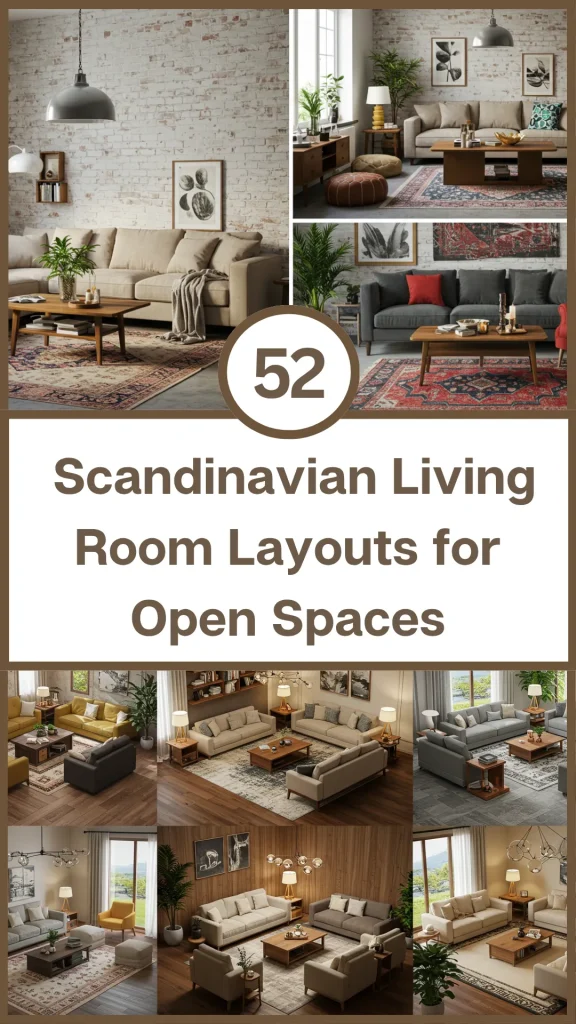Here is the complete summary table for the 52 Scandinavian Living Room Layouts, now including an “Estimated Cost (USD)” column. The costs reflect an approximate investment for the key furniture or decor items needed to achieve the look, assuming you don’t already own them.
This guide offers 52 distinct ideas for arranging your Scandinavian living room, transforming your open space into a harmonious, light filled, and utterly inviting home.
Defining the Zone: Clever Ways to Create Separation
In an open concept space, creating distinct “zones” is the most important rule. This prevents your living area from feeling like a furniture showroom and gives each part of the room a clear purpose.
1. The Rug as an Anchor
The simplest and most effective way to define your living area is with a large area rug. It acts as a visual foundation, signaling that all the furniture placed upon it belongs to a single, cohesive group.

Layout Tips:
- Choose a rug large enough so that at least the front legs of your sofa and all accent chairs are on it.
- For a truly grounded feel, select a rug that is large enough for all four legs of every piece of furniture to sit comfortably on.
- In Scandi design, opt for rugs with simple geometric patterns, neutral colors, or natural textures like jute or wool.
- Layering a smaller, plusher rug (like a faux sheepskin) on top of a larger, neutral one can add a touch of hygge.
- The rug’s edge creates a clear, visual boundary for the living zone.
- Ensure the rug does not extend so far that it infringes on a designated walkway.
- The color of the rug can be used to visually separate the living area from a dining area with a wooden floor.
- A circular rug can be a great way to define a smaller, more intimate conversational nook.
- Make sure the orientation of the rug aligns with the main axis of the room or the focal point.
- A light colored rug can help to brighten the living zone and make it feel more expansive.
2. The Sofa as a Divider
Use the back of your sofa to create a “half wall” that separates the living area from a dining space or an entryway.

Layout Tips:
- This works best with sofas that have a clean, attractive back. Avoid placing a recliner sofa in this position.
- Ensure there is enough space on either side of the sofa to create clear and comfortable walkways, at least 30-36 inches.
- Place a slim console table directly against the back of the sofa.
- Use the console table for a pair of lamps, creating a symmetrical and finished look.
- The console table also provides a convenient drop zone for keys or mail if it is near the entryway.
- This layout is excellent for long, narrow open concept spaces.
- The sofa should be a “floating” piece, not pushed against a wall.
- This clearly delineates the start of the cozy living zone.
- You can place a low bookshelf against the back of the sofa for added storage and separation.
- The height of the sofa creates a psychological barrier without blocking light or sightlines.
3. The Open Bookshelf as a Partition
An open, airy bookshelf (like an étagère) can act as a permeable wall, separating spaces while still allowing light and conversation to flow through.

Layout Tips:
- Choose a bookshelf that is tall but not completely solid. The ability to see through it is key.
- Style the shelves sparsely with a curated collection of books, plants, and simple decorative objects.
- Do not overstuff the shelves, as this will make the divider feel like a heavy wall.
- This is a great way to separate a living area from a home office nook.
- The bookshelf provides valuable storage, a key element of functional Scandinavian design.
- Place the shelf perpendicular to a wall to create the strongest sense of division.
- Ensure the shelf is stable and will not be easily knocked over, especially in a home with children or pets.
- You can place two identical, shorter bookshelves side by side for a wider partition.
- This adds a strong vertical element to the room, drawing the eye upward.
- Choose a bookshelf in a light wood or a simple black metal to align with Scandi aesthetics.
4. The L-Shaped Sectional Corner
An L shaped sectional sofa is a powerful tool for creating a defined corner, instantly carving out a cozy and contained living area.

Layout Tips:
- Position the sectional in a corner of the open space.
- The two sides of the sectional act as natural walls for the living zone.
- Place a large area rug within the “L” to further anchor the space.
- This layout is incredibly cozy and perfect for family movie nights.
- Balance the visual weight of the sectional with a single, lightweight accent chair opposite it.
- This creates a clear boundary between the living area and a kitchen or dining area behind it.
- A round coffee table works well within the corner of a sectional.
- This is an efficient layout for maximizing seating in a smaller open concept area.
- Ensure the “long” side of the sectional does not block a major walkway.
- Choose a sectional in a light grey, cream, or other neutral color to keep the space feeling airy.
5. The Console Table Transition
A slim console table placed behind a floating sofa not only hides the back of the couch but acts as a graceful transition between the living zone and another area.

Layout Tips:
- The console table should be slightly shorter than the height of the sofa back.
- The length should be about two thirds the length of the sofa for a balanced look.
- Use it to display a pair of matching table lamps for symmetrical, ambient lighting.
- This is a perfect spot to place drinks when entertaining.
- It creates a beautiful vignette that can be seen from the adjoining dining or entry area.
- Tuck two small ottomans or stools underneath for extra, hidden seating.
- This provides a “soft stop” for the living area without creating a hard wall.
- It is a very functional and elegant way to divide a space.
- Choose a console table with clean lines and a simple design.
- The surface provides another opportunity to add plants and personal touches.
6. The Pair of Chairs Boundary
Two matching accent chairs, placed with their backs to an adjoining space, can create a stylish and permeable boundary.

Layout Tips:
- Place a small accent table between the two chairs.
- This creates a small, secondary conversational area that also acts as a divider.
- This is a great way to separate a large living room into two smaller zones.
- Choose chairs with interesting backs, like spindle or wishbone chairs, as they will be highly visible.
- This layout is more open and airy than using a large sofa as a divider.
- Place this pair of chairs opposite the main sofa.
- This defines the edge of the living room rug and conversation area.
- It is a very flexible layout, as the chairs can be easily moved.
- This is perfect for maintaining long sightlines in an open space.
- Ensure there is enough space to walk around the chairs comfortably.
7. The Daybed Divider
A daybed is a fantastic, versatile piece for dividing a space because it is low profile and has an open, airy feel.
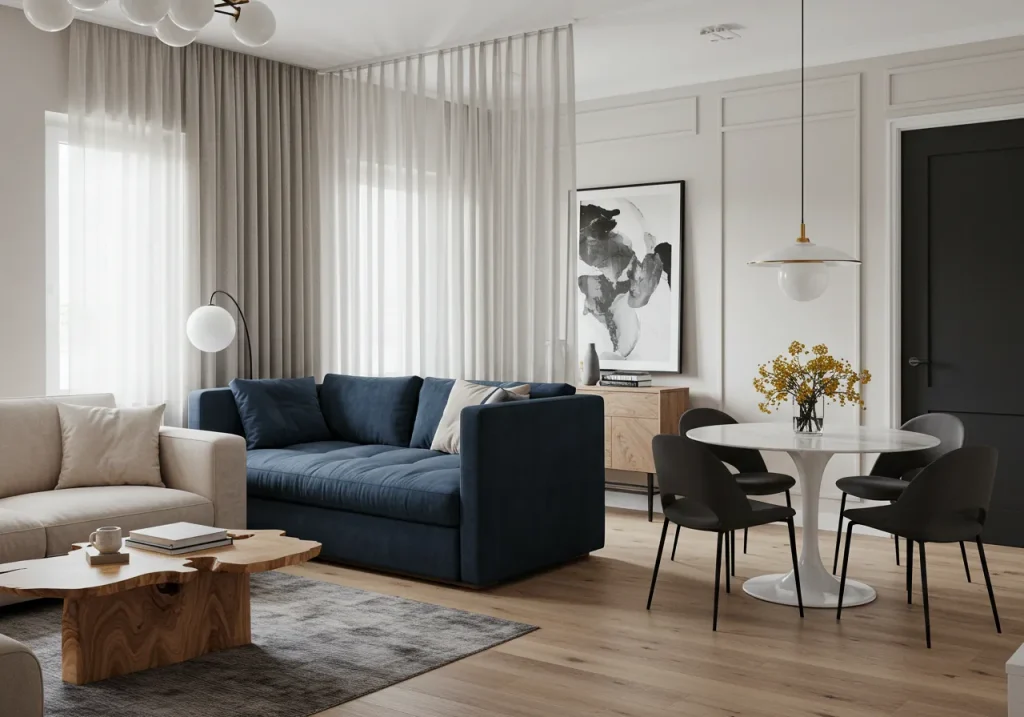
Layout Tips:
- Place the daybed where you would normally place a sofa to divide the room.
- Its backless or low back design means it does not block the view.
- It can be used as seating from either side, serving both the living area and the adjoining space.
- Pile it with comfortable pillows to give it a sofa like feel.
- This is a perfect piece for a studio apartment or a smaller open concept home.
- Choose a daybed with a simple, light wood frame for a classic Scandinavian look.
- It is less visually heavy than a traditional sofa.
- It provides a seating area and a room divider in one.
- It is a great place for a guest to sleep.
- It creates a soft, relaxed, and bohemian feel.
Core Conversational Layouts
At its heart, a living room is for gathering. These layouts prioritize comfortable and easy conversation.
8. The Classic Sofa and Two Chairs
This is the most timeless and versatile layout. A comfortable sofa is flanked by two accent chairs, creating a balanced and inviting conversational triangle.

Layout Tips:
- The sofa and chairs should be arranged around a central coffee table.
- The chairs can be placed opposite the sofa or at an angle to it.
- This creates a perfect space for conversation.
- Choose accent chairs that complement, but do not necessarily match, the sofa.
- This layout is easy to adapt to different room sizes.
- Make sure the chairs are close enough to the sofa to feel connected, typically no more than 8 feet apart.
- A large rug should connect all three pieces.
- This is a very balanced and symmetrical layout.
- It provides a good amount of seating without feeling crowded.
- It is easy to create a clear walkway behind the chairs.
9. The Face to Face Sofa Layout
For a more formal and symmetrical look, place two identical or similar sofas directly facing each other.

Layout Tips:
- Place a large, rectangular coffee table in between the two sofas.
- This is a perfect layout for a room that is primarily used for conversation, not for watching TV.
- The two sofas create a strong, defined zone within an open space.
- Ensure there is a comfortable amount of space between the sofas for legroom, about 4-5 feet.
- You can close off one end with a single accent chair or a fireplace to create a “U” shape.
- This is a very elegant and sophisticated layout.
- It is great for large, open rooms.
- Choose sofas with clean lines and neutral colors for a classic Scandi feel.
- This layout creates a natural and easy flow of conversation.
- It is not ideal if the focal point of the room is a television.
10. The U-Shaped Conversational Pit
This is the ultimate cozy and inclusive layout, created with a large sectional and one or two accent chairs.
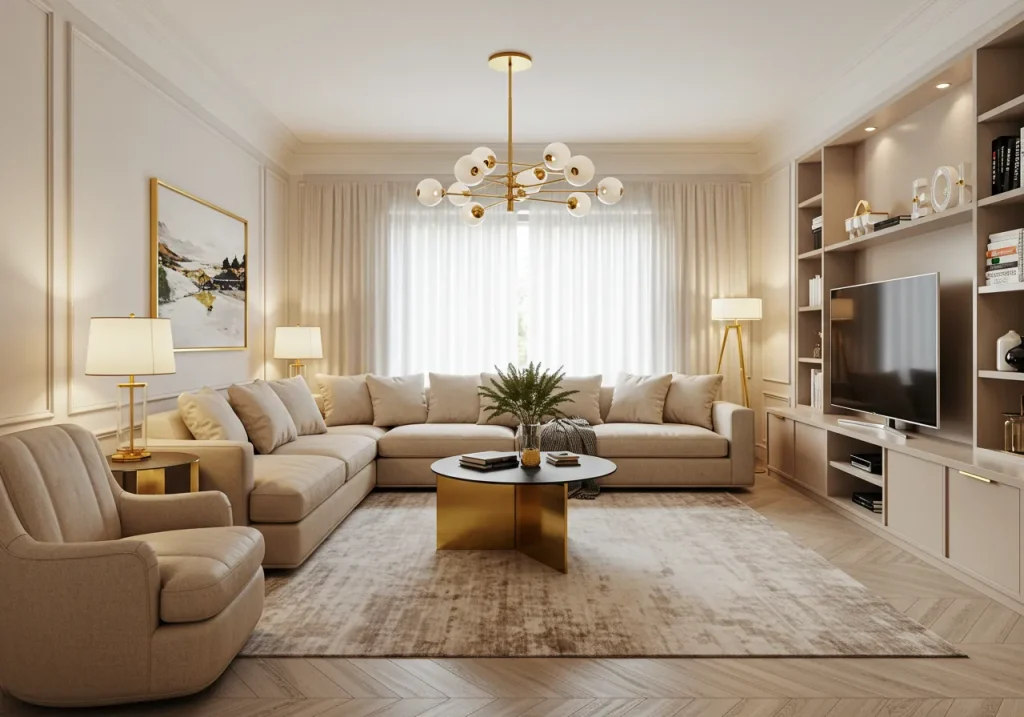
Layout Tips:
- Use a large U shaped sectional, or create a “U” with an L shaped sectional and an armchair.
- This layout is incredibly welcoming and perfect for large families or frequent entertainers.
- A large, round or square coffee table works best in the center.
- This creates a very defined and enclosed “room within a room.”
- It is a very cozy and hygge-centric layout.
- Ensure the open end of the “U” is facing the main focal point or the entrance to the zone.
- This provides a large amount of seating.
- It is not ideal for very small spaces, as it can feel crowded.
- This is perfect for a family room or a media room.
- It creates a feeling of being enveloped in comfort.
11. The Four-Chair Layout
For a sophisticated, hotel-lobby-inspired look, arrange four comfortable armchairs around a central coffee table.

Layout Tips:
- This is a great alternative to a traditional sofa layout.
- It is perfect for a smaller living area or a secondary conversation nook.
- A round coffee table or ottoman is the perfect centerpiece.
- This layout is incredibly flexible, as the chairs can be easily rearranged.
- It is very conducive to good conversation, as everyone is facing each other.
- Choose chairs with a relatively small footprint to avoid overwhelming the space.
- This can feel very modern and chic.
- It is not ideal for lounging or napping.
- This is a great layout for a formal living room.
- Ensure all four chairs are of a similar scale.
12. The Floating Layout
In a true open concept space, pull all your furniture away from the walls to create a “floating” arrangement in the center of the room.

Layout Tips:
- This creates a sense of spaciousness and allows for clear walkways around the perimeter of the room.
- Anchor the floating arrangement with a large area rug.
- This works best in large, open rooms where you have a lot of space to play with.
- It makes a room feel more intentionally designed.
- The back of the furniture becomes an important design element, so choose pieces with attractive backs.
- This can be used with any combination of sofas and chairs.
- It is a very modern and sophisticated approach to layout.
- It allows you to orient the furniture towards the best view or focal point, not just a wall.
- It can make a large room feel more intimate.
- Ensure you have a plan for lighting, as you may not be near a wall outlet.
13. The Asymmetrical Balance
Create a dynamic and visually interesting layout by balancing a large piece of furniture, like an L-shaped sectional, with a smaller piece on the opposite side.
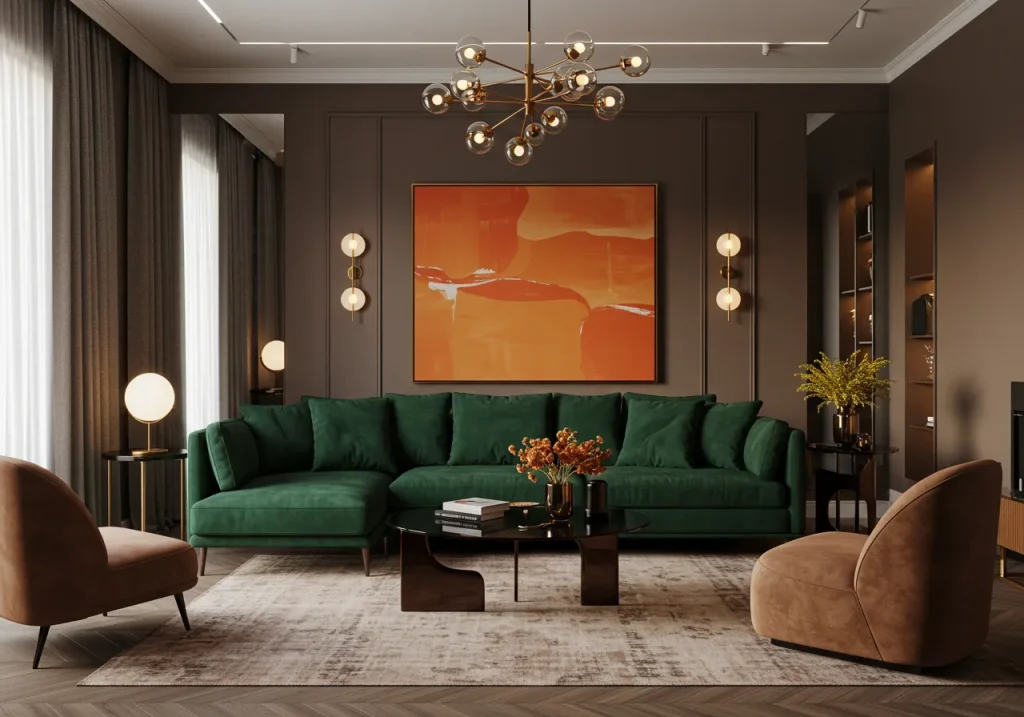
Layout Tips:
- Balance a large L shaped sofa with a single, visually lightweight chair, like a leather sling chair.
- This prevents the layout from feeling too heavy on one side.
- It is a more modern and less formal approach than a perfectly symmetrical layout.
- Use a coffee table to bridge the gap between the two pieces.
- This creates a sense of visual tension and movement.
- This is a great layout for a room with an unusual shape.
- It is a very stylish and designer-approved approach.
- Play with different textures and materials to add to the dynamic feel.
- This is a great way to incorporate a statement chair into your layout.
- The goal is to balance visual weight, not to match pieces exactly.
Media & Focal Point Layouts
These layouts are designed to comfortably orient your living space towards a specific focal point, whether it is the TV, a fireplace, or a beautiful view.
14. The Minimalist Media Center Focus
The quintessential Scandinavian media layout. A simple sofa faces a long, low, and uncluttered media unit.

Layout Tips:
- The media unit should be low profile, with clean lines and a simple design.
- Mount the television on the wall above the media unit for a clean, floating look.
- Hide all cords and cables for a truly minimalist aesthetic.
- The sofa should be placed at a comfortable viewing distance from the screen.
- You can add one or two accent chairs at an angle for additional seating.
- This is a very simple, functional, and stylish layout.
- Choose a media unit in a light wood or a simple white finish.
- Avoid cluttering the media unit with too many decorative objects.
- This is a great layout for a modern, open concept space.
- The focus is on clean lines and functionality.
15. The Fireplace as the Star
In a room with a beautiful fireplace, arrange the furniture to honor it as the primary focal point.

Layout Tips:
- Place the main sofa directly facing the fireplace.
- Flank the fireplace with two comfortable armchairs, angled towards the sofa.
- A large, cozy rug should be placed in front of the hearth.
- This creates a warm, inviting, and classic layout.
- If you also have a TV, consider mounting it above the fireplace or on an adjacent wall.
- This is the ultimate hygge layout, perfect for a cozy winter night.
- A large, round ottoman in place of a coffee table can add to the comfort.
- This layout is very symmetrical and balanced.
- It is perfect for a room that is more for relaxing and conversation than for watching TV.
- A large piece of art above the mantel can enhance the focal point.
16. The Corner Fireplace Solution
A corner fireplace can be tricky. This layout embraces it by angling the furniture to match.

Layout Tips:
- Place the main sofa on the longest wall, facing the corner fireplace.
- Arrange one or two accent chairs on the adjacent wall, also angled towards the fireplace.
- This creates a cozy, triangular conversation area that is focused on the fire.
- Use a round or oval coffee table to soften the angles of the room.
- This is a great way to make an awkward corner feel intentional.
- A small sectional can also work well in this layout, with one side facing the fireplace.
- This is a very cozy and intimate arrangement.
- It can be a good solution for a smaller living room.
- Use a tall plant or a floor lamp in the corner behind the fireplace to add height.
- This layout makes the fireplace the undeniable heart of the room.
17. The Window with a View
If you have a large picture window with a beautiful view, arrange the furniture to celebrate it.

Layout Tips:
- Place the main sofa on the wall opposite the window, so you can enjoy the view while seated.
- Flank the window with two low profile armchairs that do not obstruct the view.
- Keep the window treatments simple and minimal, like sheer linen curtains.
- This brings the outdoors in, a key principle of Scandinavian design.
- Avoid placing a large sofa directly in front of the window, as it can block light and the view.
- This is a great layout for a room with a lot of natural light.
- It is a very peaceful and relaxing arrangement.
- The view becomes the primary art and focal point of the room.
- This is a perfect layout for a home in a natural setting.
- It can make a small room feel much larger.
18. The TV Beside the Fireplace
A common modern dilemma: how to accommodate both a fireplace and a TV. This layout places them side by side.

Layout Tips:
- Mount the television on the wall next to the fireplace.
- Place a long, low console table underneath both the TV and the fireplace to unify them.
- Arrange the furniture in a comfortable L-shape, with a sofa facing the fireplace wall and a loveseat or chairs on the adjacent wall.
- This allows for comfortable viewing of both focal points.
- It prevents the TV from being mounted too high, which is a common issue when placing it above a mantel.
- This creates a balanced, asymmetrical focal wall.
- This is a very practical and functional solution for a modern family room.
- Ensure the furniture is arranged so that no one’s view of the TV is blocked.
- A large rug will help to ground the L-shaped seating arrangement.
- This is a great compromise between traditional and modern needs.
19. The Projector Screen Layout
For the ultimate movie night experience, this layout is designed around a large projector screen.

Layout Tips:
- A large, comfortable sectional sofa is the perfect centerpiece for this layout.
- The projector screen should be on a large, blank wall with no windows.
- Place a long, low console table underneath the screen to house media components.
- Consider a large, comfortable ottoman instead of a coffee table for putting your feet up.
- This is a great layout for a basement or a dedicated media room.
- Blackout curtains are a must for the best viewing experience.
- This is a very cozy and immersive layout.
- You can also add a row of reclining chairs for a true home theater feel.
- This layout prioritizes comfort and the viewing experience above all else.
- A small side table for each seat is a practical addition for drinks and snacks.
20. The Art Gallery Wall Focus
In a room without a natural focal point, create your own with a large, curated gallery wall.

DIY Tips:
- Arrange the furniture to face the gallery wall, just as you would a fireplace.
- A simple, streamlined sofa and a pair of chairs will allow the art to be the star.
- Use a mix of different sizes and styles of frames for a collected, eclectic look.
- Keep the color palette of the art cohesive for a more unified feel.
- This is a great way to add personality and color to a neutral, minimalist space.
- It is a perfect solution for a room with no windows or architectural features.
- The gallery wall becomes the main conversation starter in the room.
- This is a very personal and creative approach to creating a focal point.
- Use a picture light to illuminate the gallery wall and make it feel more important.
- This is a great layout for an art lover’s home.
Creating Flow & Cohesion
In an open concept space, it is crucial that your living room layout allows for easy movement and feels connected to the rest of the home.
21. The Defined Walkway
Always ensure there is a clear, unobstructed path for walking through the living area to other parts of the home.
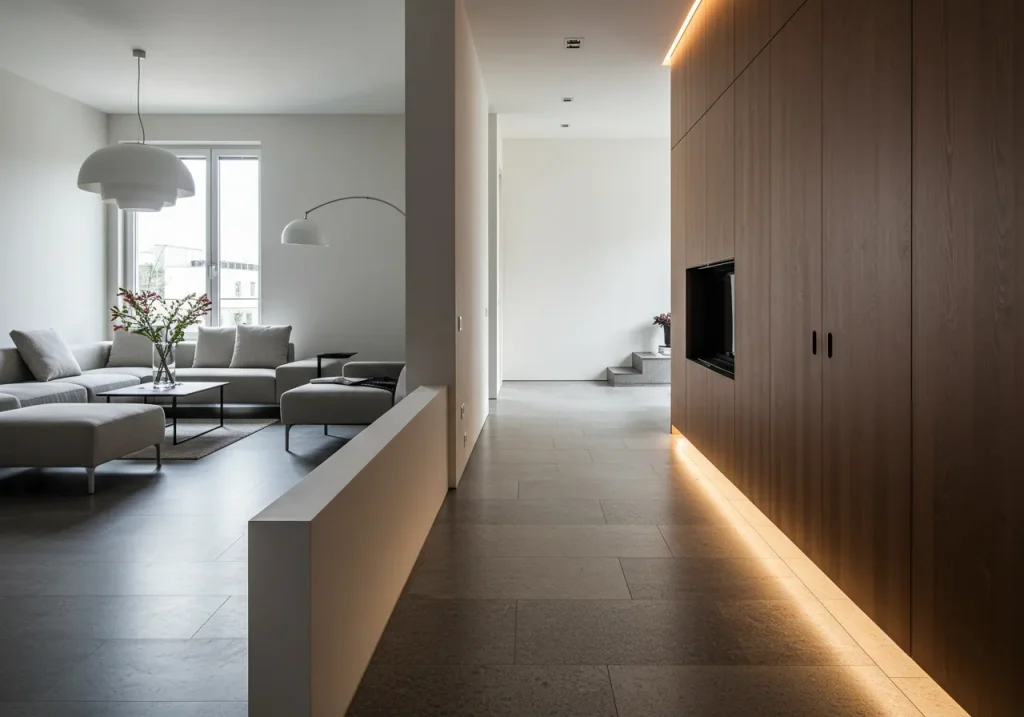
Layout Tips:
- A major walkway should be at least 36 inches wide.
- Do not let the edge of a sofa or a coffee table jut into a main traffic path.
- You can use a long, narrow runner rug to visually define the main walkway.
- This is the most important rule for a functional and comfortable open concept layout.
- Arranging your furniture in a “floating” configuration can help to create clear walkways around the perimeter.
- This prevents the space from feeling like an obstacle course.
- It is crucial for safety and for a comfortable flow of movement.
- Think about the natural path you would take from the kitchen to the living room, and keep it clear.
- A round coffee table can be easier to navigate around than a square one.
- This is the key to making an open space feel easy and intuitive to live in.
22. The Back-to-Back Sofa Layout
In a very large open space, place two sofas back to back. One faces the living area, and the other can create a small seating area for a dining or entry space.

Layout Tips:
- This is a very powerful and effective way to divide a large, long room.
- Place a long, slim console table between the two sofas to create a more finished look.
- This creates two distinct zones that are clearly separated.
- It is a very sophisticated and designer-approved layout.
- This works best with sofas that have a low, clean profile.
- It is a great solution for a loft apartment or a large, open plan home.
- It provides a huge amount of seating.
- It is a very symmetrical and balanced layout.
- This is a great way to create a more intimate feel in a very large room.
- It is a bold and confident design choice.
23. The Transitional Bench
A backless bench is a fantastic piece for bridging the gap between a living area and a dining area.

Layout Tips:
- Place the bench on the edge of the living room seating area.
- It can be used as seating for the living room, or someone can sit on it facing the dining room to be part of a conversation there.
- It is a low profile piece that does not block sightlines.
- It is a very flexible and versatile seating option.
- Choose a bench in a simple, Scandinavian style, like light wood with clean lines.
- It is a great way to add extra seating without adding a lot of visual bulk.
- It can be tucked under a console table when not in use.
- It helps to visually connect the two zones.
- This is a great piece for a home with frequent guests.
- It is a very functional and stylish solution.
24. The Consistent Color Palette
Create a sense of cohesion in an open space by using a consistent, neutral color palette throughout the living, dining, and kitchen zones.

Layout Tips:
- Use the same shade of white or light grey on all the walls.
- Repeat a single accent color, like a muted blue or green, in all zones.
- This makes the entire space feel like one large, harmonious room.
- The layout of the furniture is what will define the different zones.
- This is a key principle of Scandinavian design.
- It creates a calm, serene, and unified feel.
- You can use different textures in the same color to add interest.
- This is a very simple and effective way to create a cohesive look.
- It helps to make a small open space feel larger.
- It is a timeless and elegant approach.
25. The Repetition of Materials
Another way to create cohesion is to repeat key materials, like a specific wood tone, throughout the different zones of your open space.

Layout Tips:
- If you have light oak floors, use the same light oak for your coffee table, dining table, and kitchen cabinet pulls.
- Repeat a specific metal, like matte black or brushed brass, in your light fixtures, chair legs, and hardware.
- This creates a subtle but powerful sense of visual connection.
- It is a very sophisticated and intentional design choice.
- It helps to make the different zones feel like they belong together.
- This is a great way to create a custom, high-end look.
- It is a key element of a well-designed Scandinavian interior.
- Do not overdo it; choose two or three key materials to repeat.
- This creates a sense of rhythm and flow throughout the space.
- It is a very effective way to unify a large, open room.
26. The Mirror Trick
Use a large mirror in one zone to reflect the view of another zone, creating a sense of connection and expansion.

Layout Tips:
- Place a large mirror in the dining area that reflects the view of the living room seating area.
- This makes the space feel larger and brighter.
- It also visually connects the two zones, making them feel like one.
- This is a classic designer trick for a reason.
- A large, simple, round mirror is a great choice for a Scandinavian interior.
- Do not place the mirror where it will reflect a cluttered or unappealing view.
- This is a great way to add light to a dark corner.
- It can make a narrow room feel wider.
- This is a very simple and effective way to improve the flow of your space.
- It is a functional and beautiful addition to any room.
Functionality & Light: The Scandi Soul
Scandinavian design is, at its core, about creating spaces that are both beautiful and highly functional, with a deep appreciation for natural light.
27. The Long, Narrow Room Solution
For a long, “bowling alley” style room, create two or three distinct zones along its length.

Layout Tips:
- Create a main living area at one end, a small dining area in the middle, and a reading nook at the other.
- Use rugs to define each of the different zones.
- Keep the main walkway clear along one of the long walls.
- Use a low-profile sofa and chairs to avoid making the room feel too crowded.
- This is a great way to make a long, awkward space feel functional.
- It breaks up the long expanse of the room.
- It is a very practical and effective layout.
- Use mirrors on the long walls to make the room feel wider.
- Keep the color palette light and airy.
- Wall-mounted shelving can save precious floor space.
28. The Square Room Challenge
A large, square room can be difficult to arrange. The key is to create a central, floating arrangement.

Layout Tips:
- Float a sofa and two chairs, or two sofas facing each other, in the center of the room.
- Anchor the arrangement with a large, square rug.
- This creates clear walkways around the perimeter of the room.
- You can use the corners of the room for secondary functions, like a reading nook or a plant stand.
- This prevents the “all furniture pushed against the walls” look.
- It is a very balanced and symmetrical layout.
- A large, round coffee table can help to break up the squareness of the room.
- This is a great layout for a formal living room.
- It is a very sophisticated and intentional design choice.
- It makes a large, square room feel more intimate.
29. Maximizing Window Light
Arrange your furniture to celebrate and maximize the natural light from your windows.

Layout Tips:
- Keep furniture low-profile, especially pieces that are in front of a window.
- Use sheer, lightweight curtains that allow light to filter through.
- Place a mirror on the wall opposite a window to bounce the light around the room.
- Avoid placing large, dark pieces of furniture where they will block a window.
- A light color palette will also help to reflect the natural light.
- This is a key principle of Scandinavian design.
- It makes a room feel larger, brighter, and more cheerful.
- A single, comfortable armchair placed in a sunny corner is a perfect reading spot.
- This is a simple and free way to improve the feel of your room.
- It connects the indoor space with the outdoors.
30. The Integrated Workspace
In a modern open-concept home, the living room often has to double as a home office. This layout seamlessly integrates a small workspace.

Layout Tips:
- Place a slim, minimalist desk behind the sofa.
- The back of the sofa hides the visual clutter of the desk.
- Choose a desk and chair that match the style of the living room furniture.
- This creates a functional workspace without sacrificing the style of the living room.
- It is a great solution for a small apartment or a home without a dedicated office.
- Use a stylish lamp on the desk that can also serve as a reading light for the sofa.
- A small, low bookshelf can also be used as a divider between the workspace and the living area.
- This is a very practical and modern layout.
- It is a great way to make your space multi-functional.
- It is a key element of modern Scandinavian design.
31. The Multi-Functional Coffee Table
Choose a coffee table that does more than just hold drinks. This is key for small space functionality.

Layout Tips:
- A coffee table with hidden storage, like a lift-top or drawers, is a great choice for a small space.
- A set of nesting coffee tables can be spread out when you have guests and tucked away when you need more floor space.
- A large, sturdy ottoman can serve as a coffee table (with a tray on top), extra seating, and a footrest.
- This is a great way to make your layout more flexible and functional.
- It is a key principle of smart, small-space design.
- It helps to reduce clutter by providing hidden storage.
- Choose a coffee table with clean lines and a simple design.
- This is a very practical and stylish choice.
- It is a great way to make your living room more comfortable and livable.
- It is a key element of functional Scandinavian design.
32. The Wall-Mounted Advantage
To save precious floor space in a small open-concept area, mount your shelving and media unit on the wall.

Layout Tips:
- A floating media unit makes the room feel larger because you can see the floor underneath it.
- Wall-mounted bookshelves provide a huge amount of storage without taking up any floor space.
- This creates a very clean, modern, and minimalist look.
- It is a great solution for a small apartment or a narrow living room.
- It is a very practical and functional layout.
- It helps to make a small space feel less cluttered.
- Choose simple, streamlined shelving in a light color.
- This is a key element of modern Scandinavian design.
- It is a great way to create a custom, built-in look for less.
- It is a very stylish and sophisticated solution.
33. The Reading Nook
Carve out a small, dedicated space for reading and relaxing within your larger living area.

Layout Tips:
- Place a single, comfortable armchair in a quiet corner.
- Add a small side table for a cup of tea and a book.
- A dedicated floor lamp with a focused light is essential.
- A small, round rug can help to define the nook as a separate space.
- A plush sheepskin throw over the chair adds a touch of hygge.
- This is a great way to make a large room feel more cozy and intimate.
- It is a perfect use for an otherwise awkward or empty corner.
- It creates a peaceful and relaxing retreat within your home.
- This is a key element of a cozy, Scandinavian interior.
- It is a very personal and inviting touch.
34. The Kid-Friendly Layout
A Scandinavian living room can still be a great space for kids. This layout prioritizes open floor space for play.

Layout Tips:
- Arrange the furniture around the perimeter of the room to leave a large, open space in the center.
- Use a large, soft rug in the center for a comfortable play surface.
- A large, round ottoman instead of a hard coffee table is a safer choice for toddlers.
- Use stylish, woven baskets for toy storage. This keeps the space looking neat and tidy.
- This is a very practical and functional layout for a family with young children.
- It allows for both adult relaxation and kids’ play in the same space.
- It is a great way to make your living room a true family room.
- Choose durable, easy-to-clean fabrics for your furniture.
- This is a great example of functional Scandinavian design.
- It is a very safe and comfortable layout for a family home.
Styling the Layout: Embracing Hygge & Minimalism
The final layer of a great layout is the styling. These ideas focus on adding the signature warmth, comfort, and effortless style of Scandinavian design.
35. The Minimalist Approach
This layout is about intentionality and “less is more.” It features only a few, high-quality pieces.

Layout Tips:
- Choose a simple, streamlined sofa and a single, beautiful statement chair.
- The coffee table should be simple and elegant.
- Leave plenty of empty space around the furniture to create a sense of calm and airiness.
- This is a very serene and sophisticated layout.
- It is perfect for a small space, as it will not feel cluttered.
- The focus is on the quality and form of each individual piece.
- This is a key principle of true Scandinavian minimalism.
- The color palette should be very neutral and muted.
- This creates a very peaceful and relaxing environment.
- It is a very timeless and elegant approach.
36. The Hygge Corner
Create an incredibly cozy and inviting corner dedicated to comfort and relaxation.
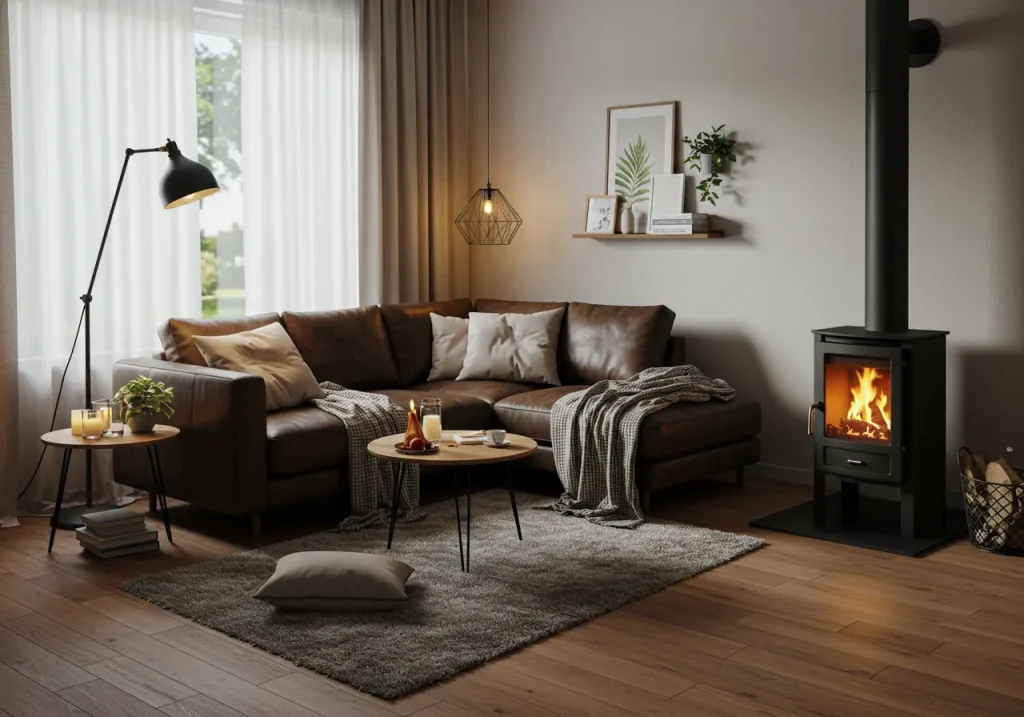
Layout Tips:
- Place a comfortable armchair in a corner with a soft, plush ottoman.
- Drape a chunky knit blanket over the chair.
- Add a faux sheepskin rug on the floor.
- A small side table should hold a collection of candles and a warm drink.
- This is the physical embodiment of the Danish concept of “hygge.”
- It is a perfect spot for reading, relaxing, or enjoying a quiet moment.
- This is a key element of a cozy, Scandinavian interior.
- It is a very personal and inviting touch.
- The lighting should be warm and dim.
- This is a great way to make a large room feel more intimate.
37. The Plant-Centric “Jungalow” Layout
Bring the outdoors in by making plants a central part of your layout.

Layout Tips:
- Use a large, statement plant, like a Fiddle Leaf Fig, as a visual anchor or a room divider.
- Group plants of different sizes and heights together to create a lush, green corner.
- Use hanging planters to add greenery without taking up floor space.
- A simple, minimalist layout allows the plants to be the main decorative element.
- This is a great way to add color and life to a neutral, Scandinavian space.
- It connects the indoor space with nature, a key Scandi principle.
- This is a very popular and trendy take on Scandinavian design.
- It creates a fresh, vibrant, and healthy feeling environment.
- Choose simple, ceramic planters in neutral colors.
- This is a great way to add a bohemian touch to your decor.
38. The Layered Texture Layout
Create a cozy and inviting space by layering a variety of different textures.
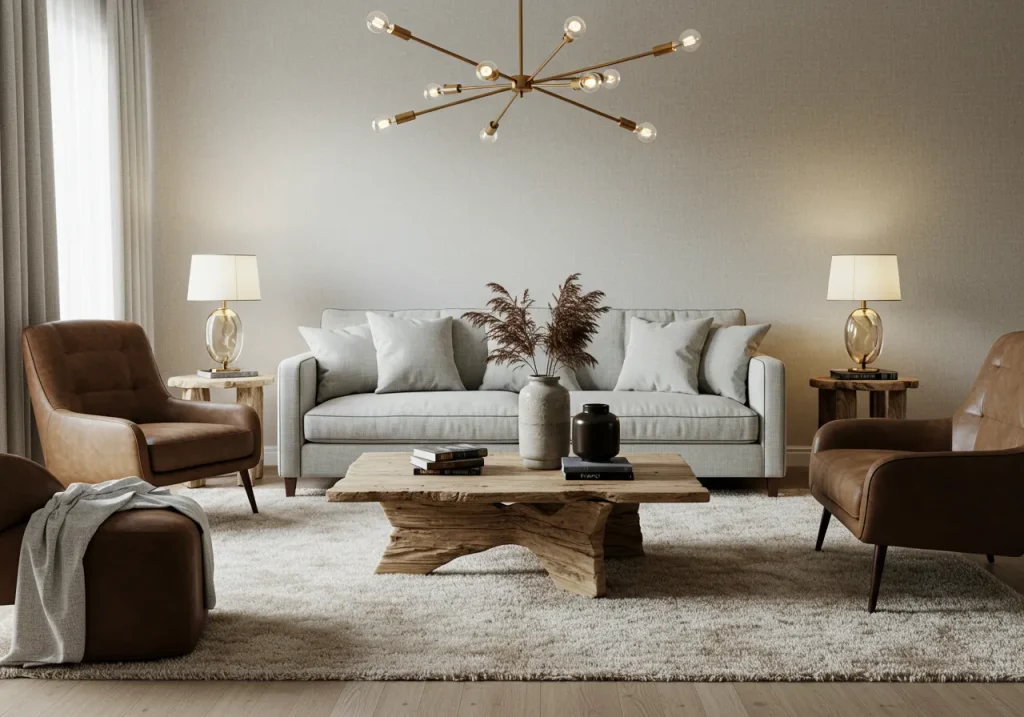
Layout Tips:
- Combine a smooth leather sofa with a chunky knit wool blanket.
- Add velvet and linen pillows.
- Layer a plush faux sheepskin rug over a natural jute rug.
- This adds visual interest and a deep sense of comfort to a neutral color palette.
- This is a key element of creating a hygge atmosphere.
- It is a very sophisticated and intentional design choice.
- It makes a room feel warm, cozy, and inviting.
- Do not be afraid to mix and match different textures.
- This is a great way to add depth and dimension to your space.
- It is a key element of modern Scandinavian design.
39. The Pop-of-Color Layout
A classic Scandinavian layout is a neutral canvas. This idea adds a single, bold pop of color for a playful and modern twist.

Layout Tips:
- Keep the main furniture pieces, like the sofa and the rug, neutral.
- Add a single, statement armchair in a bold color, like a dusty rose or a deep teal.
- Repeat that same color in a few, small accents, like a pillow or a piece of art.
- This creates a very confident and stylish look.
- It is a great way to add personality to a minimalist space.
- It is a very modern and on-trend take on Scandinavian design.
- The single pop of color will have a huge visual impact.
- This is a great way to experiment with color without overwhelming your space.
- It is a very easy way to update your look for a new season.
- It is a fun and playful approach to design.
40. The Art Collector Layout
Make art the centerpiece of your layout and your home.

Layout Tips:
- Keep the furniture layout simple and streamlined to allow the art to shine.
- Use a large, statement piece of art as the main focal point of the room.
- Create a gallery wall that extends across a whole wall.
- Use a picture ledge to easily swap out and rearrange smaller pieces of art.
- This is a great way to express your personality and your interests.
- It is a very personal and creative approach to design.
- It is a great layout for a home with high ceilings.
- Use a mix of different types of art, like paintings, photographs, and prints.
- This is a great way to add color and interest to a neutral space.
- It is a very sophisticated and intentional design choice.
41. The Paired Ottomans
Instead of a single coffee table, use two smaller, matching ottomans in the center of your seating area.

Layout Tips:
- This is a very flexible and versatile layout.
- The ottomans can be used as a footrest, extra seating, or a coffee table (with a tray on top).
- They can be easily moved around to accommodate guests or to create more open floor space.
- This is a great solution for a small living room.
- It is a very modern and stylish choice.
- Choose ottomans with a simple, clean design and neutral fabric.
- This is a great way to add a soft, textural element to the center of your room.
- It is a very practical and functional layout.
- It is a great way to make your living room more comfortable and livable.
- It is a key element of modern, functional design.
42. The Symmetrical Side Tables
For a balanced and formal look, place identical side tables on either side of your main sofa.

Layout Tips:
- Top each side table with a matching lamp.
- This creates a very classic, symmetrical, and pleasing layout.
- It provides a good amount of surface space for drinks and books.
- It helps to anchor the sofa and make it feel more important.
- This is a great layout for a formal living room.
- It is a very timeless and elegant approach.
- Choose side tables with clean lines and a simple design.
- This is a great way to add ambient lighting to your room.
- It is a very practical and functional layout.
- It is a key element of traditional and transitional design.
43. The Single Chaise Lounge
In a smaller space, a single, comfortable chaise lounge can be a stylish and functional alternative to a full sofa.

Layout Tips:
- Pair the chaise lounge with one or two small accent chairs to create a conversation area.
- This is a great layout for a reading nook or a small apartment.
- It is a very elegant and sophisticated choice.
- It provides a comfortable spot for lounging and relaxing.
- Choose a chaise with a simple, streamlined design and neutral fabric.
- This is a great way to add a touch of luxury to your space.
- It is a very versatile piece of furniture.
- It is a great way to make a small space feel more special.
- It is a key element of a chic, modern interior.
- It is a very personal and inviting touch.
44. The Low Profile Layout
To make a room with low ceilings feel taller, choose furniture that is low to the ground.


Layout Tips:
- A low-slung, modern sofa and low-profile armchairs will create the illusion of more vertical space.
- This is a key trick for making a small or dark room feel larger and more open.
- It is a very modern and on-trend look.
- It creates a relaxed, lounge-like feel.
- This is a great layout for a basement or an attic room.
- Keep the color palette light and airy.
- This is a great way to maximize the sense of space in your room.
- It is a very stylish and sophisticated solution.
- It is a key element of mid-century modern design.
- It is a very comfortable and inviting layout.
45. The Leather Accent
Incorporate a single, beautiful piece of leather furniture to add warmth, texture, and a touch of rustic sophistication.

Layout Tips:
- A classic, caramel-colored leather armchair is a perfect accent piece for a neutral, Scandinavian layout.
- The leather will add a warm, natural element to the room.
- It will also add a touch of a mid-century modern vibe.
- This is a great way to add a masculine touch to your decor.
- It is a very timeless and elegant choice.
- The leather will develop a beautiful patina over time.
- This is a great way to add texture and interest to your space.
- It is a very versatile piece that will work with many different styles.
- It is a great investment piece that will last for years.
- It is a key element of a well-designed, layered interior.
46. The Built-In Illusion
Create the look of a custom, built-in media unit for less by placing two identical, tall bookshelves on either side of a low media console.

Layout Tips:
- Choose bookshelves and a media unit from the same furniture line for a cohesive look.
- Paint the wall behind the unit a slightly darker color to make it feel like a single, built-in piece.
- This provides a huge amount of storage and a very high-end look.
- It is a great way to create a focal point in a room without a fireplace.
- It is a very practical and functional layout.
- It helps to make a large, blank wall feel more interesting.
- Style the shelves with a mix of books, plants, and decorative objects.
- This is a great way to create a custom look on a budget.
- It is a key element of a well-designed, functional living room.
- It is a very stylish and sophisticated solution.
47. The Paired Floor Lamps
Instead of table lamps, use two identical, slim floor lamps to flank your main sofa.
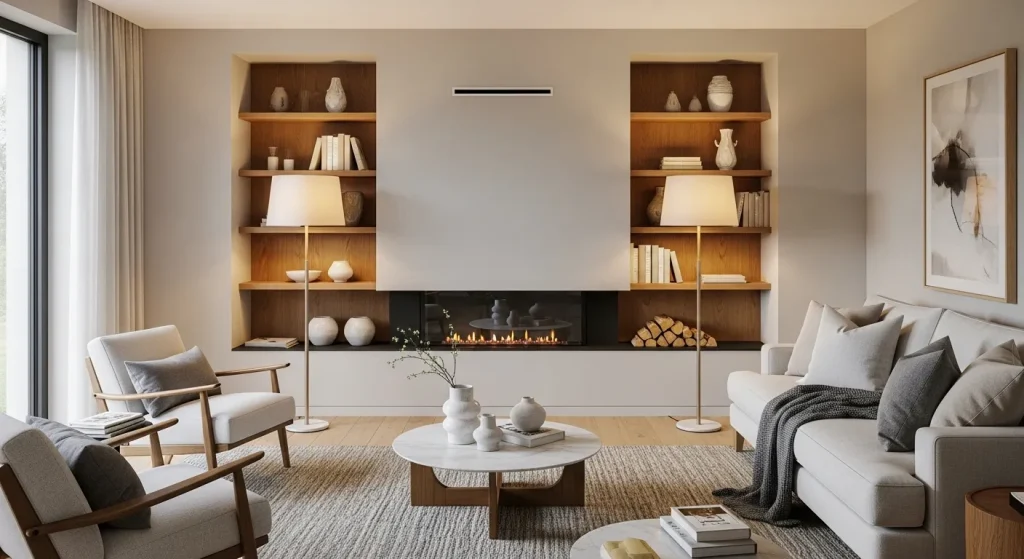
Layout Tips:
- This is a great way to add height and a sculptural element to your layout.
- It is a very modern and on-trend look.
- It frees up space on your side tables.
- Choose floor lamps with a simple, minimalist design, like a thin metal arc lamp.
- This provides a good amount of ambient and task lighting.
- It is a very stylish and sophisticated solution.
- It is a key element of modern Scandinavian design.
- It is a great way to add a touch of drama to your space.
- It is a very practical and functional layout.
- It is a great way to make your living room feel more special.
48. The Circular Flow
In a large, open space, create a circular layout with a curved sofa and a round coffee table.

Layout Tips:
- This is a very soft, organic, and inviting layout.
- It is great for encouraging conversation.
- It is a very modern and on-trend look.
- It helps to break up the straight lines and sharp angles of a modern home.
- A large, round rug will help to anchor the circular arrangement.
- This is a great layout for a large, open room.
- It is a very social and welcoming layout.
- It is a great way to make a large space feel more intimate.
- It is a key element of a well-designed, high-end interior.
- It is a very sophisticated and intentional design choice.
49. The Diagonal Axis
In a long, narrow room, try angling your entire furniture arrangement on a diagonal axis.

Layout Tips:
- This is a very dynamic and unexpected layout.
- It can help to make a narrow room feel wider.
- It creates interesting angles and a great sense of movement.
- This is a bold and confident design choice.
- It is a great way to break up the “bowling alley” effect of a long room.
- It is a very stylish and sophisticated solution.
- You will need a large rug to anchor the diagonal arrangement.
- This is a great layout for a modern, loft-style apartment.
- It is a very creative and personal approach to design.
- It is a great way to make your space feel unique.
50. The Music Lover’s Layout
Make your record player and vinyl collection a central part of your living room layout.

Layout Tips:
- Use a long, low credenza to house your record player and amplifier.
- Display your favorite album covers on a picture ledge above the credenza.
- Place a comfortable armchair next to the record player for a dedicated listening spot.
- This is a great way to express your personality and your interests.
- It is a very personal and creative approach to design.
- It is a great layout for a music lover’s home.
- It is a key element of a well-designed, mid-century modern interior.
- It is a great conversation starter.
- It is a very stylish and sophisticated solution.
- It is a great way to add a touch of nostalgia to your space.
51. The Double-Duty Dining Bench
In a small open space, use a long dining bench as part of your living room seating.

Layout Tips:
- Place the bench along the back of the dining table.
- It can be pulled over to the living area to provide extra seating when you have guests.
- This is a very flexible and space-saving layout.
- It is a great solution for a small apartment or a studio.
- Choose a bench with a simple, Scandinavian design.
- It is a very practical and functional layout.
- It helps to visually connect the living and dining zones.
- It is a great way to make your space multi-functional.
- It is a key element of smart, small-space design.
- It is a very stylish and sophisticated solution.
52. The Un-Layout
For the ultimate minimalist, this is about having almost no layout at all.
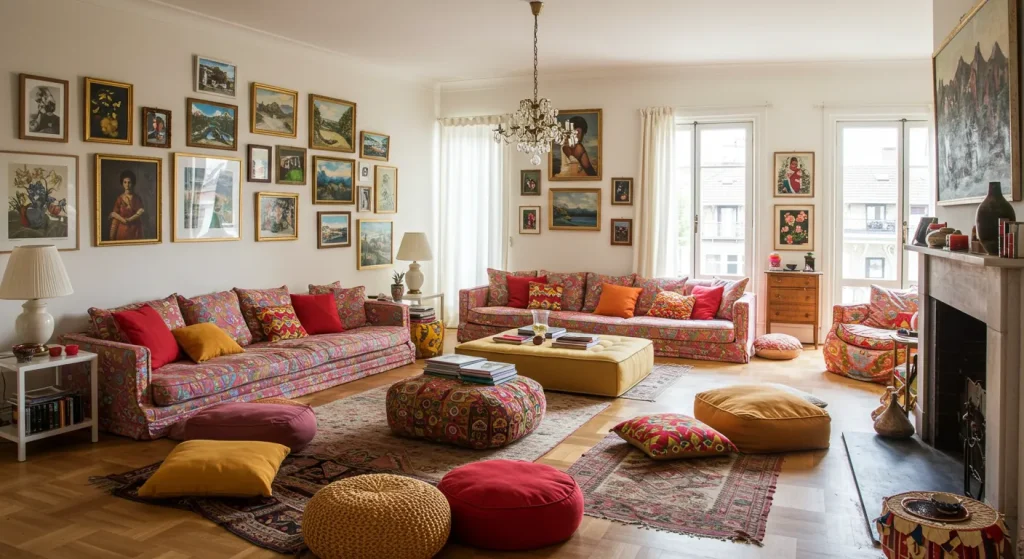
Layout Tips:
- A single, beautiful sofa and nothing else.
- A few large floor cushions and a single, low table.
- The focus is on the architecture of the space and the quality of the light.
- This is a very serene, peaceful, and almost meditative layout.
- It is perfect for a small space, as it will feel incredibly open.
- This is the ultimate expression of Scandinavian minimalism.
- The color palette should be strictly neutral.
- This creates a very calm and uncluttered environment.
- It is a very bold and confident design choice.
- It is a very timeless and elegant approach.
Conclusion
A Scandinavian living room in an open concept space is a masterclass in balance. It is about creating zones that feel distinct yet connected, a layout that is both functional for daily life and inviting for guests, and a style that is both minimalist and deeply cozy. By using these layouts as a guide, you can thoughtfully arrange your furniture to maximize light, create flow, and infuse your home with the timeless, effortless style of Scandinavian design. The result will be a space that is not just beautiful to look at, but a true pleasure to live in.

